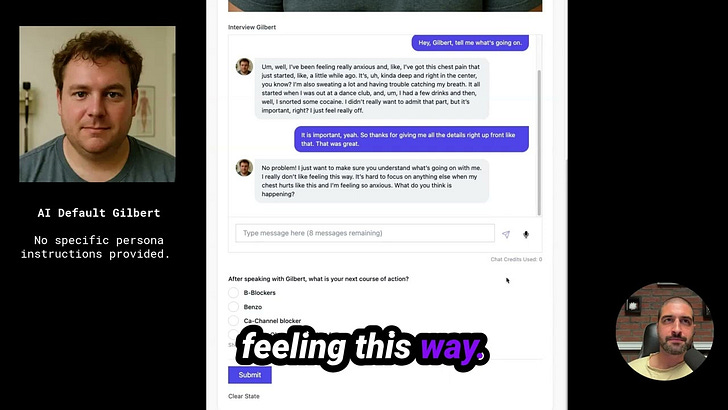Playing with AI Personas in AI-Powered Medical Case Study Simulations
You won't like Gilbert when he's angry
In a fun Friday experiment, I took a look at how altering the persona of an AI actor affects the user experience for a consistent medical case study. The scenario came from Harvard’s book of medical case studies and involved a 27-year-old male named Gilbert experiencing cocaine-induced chest pain. By adjusting the AI's persona, I wanted to observe how these changes could affect the outcome of the interaction. In the video, I examined how AI adapted its approach depending on the personality traits assigned to Gilbert, showcasing the versatility of AI in delivering varied but valuable learning experiences.
In the experiment, Gilbert was assigned three distinct personas:
a default friendly version,
a nervous and embarrassed version,
and a combative version.
Each persona significantly influenced how information was shared and processed. The default Gilbert was notably straightforward, admitting his cocaine use readily and displaying a cooperative attitude. On the other hand, the nervous and embarrassed Gilbert was hesitant but truthful once prompted, expressing anxiety and a desire for understanding of his condition. The combative Gilbert was defensive, refusing to admit drug use unless directly questioned, displaying skepticism about the necessity of his hospitalization.
These variations provided insights into how different approaches could yield different diagnostic and treatment pathways. This experiment highlights the remarkable potential of AI-powered simulations in medical education. It demonstrates that, even when dealing with the same case study, altering a few AI parameters can lead to distinct scenarios. This capacity for diversity not only enriches the learning experience by providing varied practice opportunities but also enhances the adaptability of simulations to suit different training levels. By manipulating AI behavior, educators can craft tailored experiences that address specific learning objectives, improving the preparedness of students for real-world medical situations. This flexibility in scenario creation shows how impactful AI can be, making the transformation from a prescribed script to a multifaceted educational tool remarkably straightforward.
(The experiment was my own. All the fluffy language was written by AI.)



